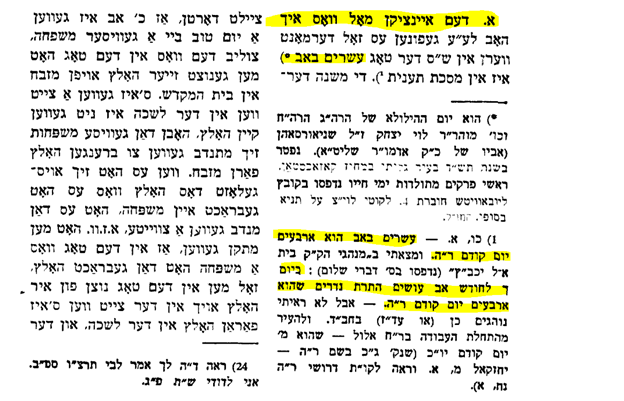BSD
Shkolim 10a.
Iyor 13, 5784. 05/21/2024
We prefaced a few facts prior to learning the next Mishnah.
שׁוֹמְרֵי סְפִיחִים בַּשְּׁבִיעִית, נוֹטְלִין שְׂכָרָן מִתְּרוּמַת הַלִּשְׁכָּה. רַבִּי יוֹסֵי אוֹמֵר, (אַף הָרוֹצֶה) מִתְנַדֵּב שׁוֹמֵר חִנָּם. אָמְרוּ לוֹ, אַף אַתָּה אוֹמֵר, שֶׁאֵינָן בָּאִין אֶלָּא מִשֶּׁל צִבּוּר.
1 – Just as a person can donate an animal (עולה ותודה) or flour (מנחה) to be brought as a קרבן, one can donate wood as well. Not just firewood for the מזבח, but wood as an actual קרבן.

שקלים 6, 1. הָאוֹמֵר, הֲרֵי עָלַי עֵצִים, לֹא יִפְחוֹת מִשְּׁנֵי גִּזְרִין.
One who says “I obligate myself to bring wood” (as a donation) should not bring less than two logs…”

2 – In מנחות כ, א we find the opinion of Reb Yossi that this קרבן of עצים is just like any other קרבן מנחה – it requires קמיצה הגשה ומלח and was not used as firewood for other קרבנות.
The רבנן say that it is not actually a מנחה although it was placed on the מזבח.
[Whether this קרבן עצים was used as firewood for other קרבנות or they were placed on the מזבח not at the center fire is another topic].
3 – The regular עצים for the מערכה were purchased with the funds of the מחצית השקל and are considered a קרבן ציבור.
4 – The grains for the מנחות were also acquired with the מחצית השקל fund.
In the year of שמיטה, this becomes an issue. Since plowing, sowing etc. is prohibited, there are no ‘new’ grains produced. One could use only produce that sprouted on their own (ספיחים) which is הפקר.
Since anyone can grab them, the only way to obtain grains for the מנחות would be to send שלוחים to these fields where there is תבואה – ספיחים to watch them until ripe and then collect these self-grown grains.

5 – The חכמים say that the salary of these שומרים also came from the מחצית השקל fund since the wheat they kept on on eye on were used for the קרבנות ציבור.
Our משנה quotes the opinion of רבי יוסי there was no need to pay for any שומרים. Anyone could volunteer to be a שומר of these fields.

6 – What is the basis for these different opinions? Paid security vs volunteers.
The גמרא in בבא מציעא 118א suggests a few explanations. One is that the issue is: by just looking at an object of הפקר one is קונה. Being that this wheat is הפקר, a mere הבטה קני.
So if an individual volunteers to keep an eye on them (least someone else takes them) they become owners of this wheat and then must gift it to the בית המקדש.
The issue is that the חכמים do dot believe that such an individual gifts it 100% to the ציבור. Now since this wheat will be used a קרבן ציבור, using a volunteer is not advisable.
רבי יוסי says that an individual can indeed donate something 100% to the ציבור.
7- The גמרא continues on this topic: Paid security vs volunteers.
It begins with the famous story of the 9 families that donated wood for the מזבח at the beginning of the בית שני era. Each family chose a particular day to supply firewood at that time of great poverty.
תענית כו, א.
These were private holidays specific to certain families, on which their members would volunteer a wood offering for the altar. There were nine such days and families: On the first of Nisan, the descendants of Araḥ ben Yehuda; on the twentieth of Tammuz, the descendants of David ben Yehuda; on the fifth of Av, the descendants of Parosh ben Yehuda; on the seventh of Av, the descendants of Jonadab ben Rechab; on the tenth of Av, the descendants of Sena’a ben Binyamin; on the fifteenth of Av, the descendants of Zattu ben Yehuda…..

On the twentieth of Av, the descendants of Paḥat Moav ben Yehuda; on the twentieth of Elul, the descendants of Adin ben Yehuda
8 – We mentioned that the Rebbe writes that the only place he found in ש”ס a mention of כ אב is the above גמרא. In the footnotes he added some other sources where this day is noted. See here.

To be continued.
קרבן קרבן עצים. מחלוקת חכמים ורבי. מנחות. כ, א. לרבי זה קרבן בכל הפרטים – כמו מנחה. הגשה קמיצה שמן ועצים וכו’. לרבנן אין זה קרבן ממש. וראה שם קו, ב. וברבינו גרשום ובריטב”א תענית כו, א.
